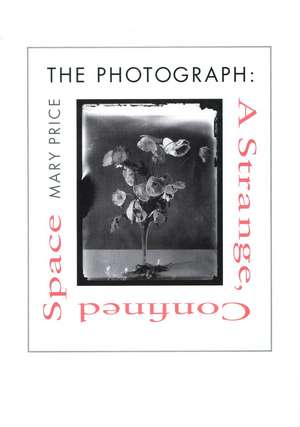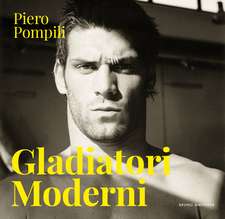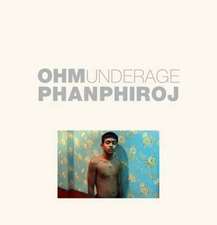The Photograph: A Strange, Confined Space
Autor Mary Priceen Limba Engleză Hardback – 31 iul 1994
This richly evocative study of photography has two major emphases, that the language of description (be it title, caption, or text) is deeply implicated in how a viewer looks at photographs, and that the use of a photograph determines its meaning.
| Toate formatele și edițiile | Preț | Express |
|---|---|---|
| Paperback (1) | 187.92 lei 3-5 săpt. | |
| Stanford University Press – 30 apr 1997 | 187.92 lei 3-5 săpt. | |
| Hardback (1) | 690.14 lei 6-8 săpt. | |
| Stanford University Press – 31 iul 1994 | 690.14 lei 6-8 săpt. |
Preț: 690.14 lei
Preț vechi: 852.03 lei
-19% Nou
Puncte Express: 1035
Preț estimativ în valută:
132.12€ • 135.88$ • 109.61£
132.12€ • 135.88$ • 109.61£
Carte tipărită la comandă
Livrare economică 17 februarie-03 martie
Preluare comenzi: 021 569.72.76
Specificații
ISBN-13: 9780804723084
ISBN-10: 0804723087
Pagini: 220
Dimensiuni: 152 x 229 x 20 mm
Greutate: 0.48 kg
Ediția:1
Editura: Stanford University Press
Colecția Stanford University Press
ISBN-10: 0804723087
Pagini: 220
Dimensiuni: 152 x 229 x 20 mm
Greutate: 0.48 kg
Ediția:1
Editura: Stanford University Press
Colecția Stanford University Press
Recenzii
"This dense, subtle, provocative book considers the question of how photographs mean in relation to the uses made of them. Unlike most critics of photography, Price makes language a subject vital to her deliberations. . . . The book builds a complicated argument about the nature of meaning and about relations between word and image, image and viewer."—Patricia Meyer Spacks, University of Virginia
"In this serious, densely textured meditation on photography (which is a study of meanings, value, and discourse as well), Price writes jargon-free prose full of wit, insight, and grace. Besides discussing photographs in their various settings, she studies the use of photographs in literary works by such writers as Proust, Lowell, Barthes, and Musil. . . . Price maintains that 'photographs without our appropriate descriptive words are deprived and weakened,' and she illuminates her idea of the photograph by enlarging on metaphors such as mask, language, and aura, the last a concept introduced by Walter Benjamin, one of the book's guiding figures. We learn much about the early practitioners of photography. (Price's analysis of Julia Margaret Cameron, whose work she studies alongside a painting by Rembrandt, is worth the price of the book.) And as an aesthetician, Price is interested in such questions as moral values (she disagrees with Sontag's condemnation of photography), authenticity, and how the mechanical aspects of the art condition the way we approach it."—Choice
Textul de pe ultima copertă
“This dense, subtle, provocative book considers the question of how photographs mean in relation to the uses made of them. Unlike most critics of photography, Price makes language a subject vital to her deliberations. . . . The book builds a complicated argument about the nature of meaning and about relations between word and image, image and viewer.”—Patricia Meyer Spacks, University of Virginia
“In this serious, densely textured meditation on photography (which is a study of meanings, value, and discourse as well), Price writes jargon-free prose full of wit, insight, and grace. Besides discussing photographs in their various settings, she studies the use of photographs in literary works by such writers as Proust, Lowell, Barthes, and Musil. . . . Price maintains that ‘photographs without our appropriate descriptive words are deprived and weakened,’ and she illuminates her idea of the photograph by enlarging on metaphors such as mask, language, and aura, the last a concept introduced by Walter Benjamin, one of the book’s guiding figures. We learn much about the early practitioners of photography. (Price’s analysis of Julia Margaret Cameron, whose work she studies alongside a painting by Rembrandt, is worth the price of the book.) And as an aesthetician, Price is interested in such questions as moral values (she disagrees with Sontag’s condemnation of photography), authenticity, and how the mechanical aspects of the art condition the way we approach it.”—Choice
“In this serious, densely textured meditation on photography (which is a study of meanings, value, and discourse as well), Price writes jargon-free prose full of wit, insight, and grace. Besides discussing photographs in their various settings, she studies the use of photographs in literary works by such writers as Proust, Lowell, Barthes, and Musil. . . . Price maintains that ‘photographs without our appropriate descriptive words are deprived and weakened,’ and she illuminates her idea of the photograph by enlarging on metaphors such as mask, language, and aura, the last a concept introduced by Walter Benjamin, one of the book’s guiding figures. We learn much about the early practitioners of photography. (Price’s analysis of Julia Margaret Cameron, whose work she studies alongside a painting by Rembrandt, is worth the price of the book.) And as an aesthetician, Price is interested in such questions as moral values (she disagrees with Sontag’s condemnation of photography), authenticity, and how the mechanical aspects of the art condition the way we approach it.”—Choice
Descriere
This richly evocative study of photography emphasizes that the language of description (be it title, caption, or text) is deeply implicated in how a viewer looks at photographs, and that the use of a photograph determines its meaning.






